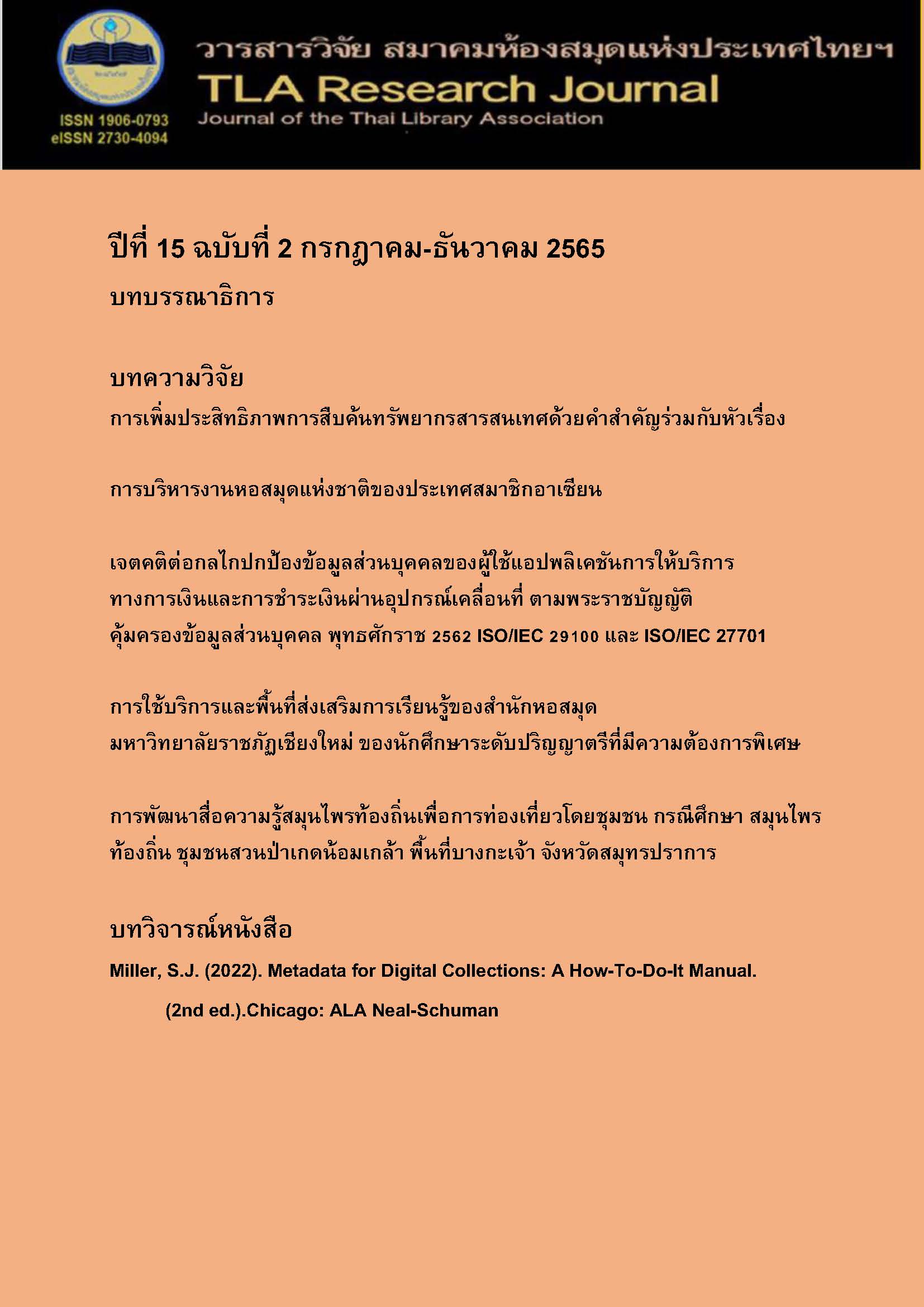การใช้บริการและพื้นที่ส่งเสริมการเรียนรู้ของสำนักหอสมุด มหาวิทยาลัยราชภัฏเชียงใหม่ ของนักศึกษาระดับปริญญาตรีที่มีความต้องการพิเศษ
Main Article Content
บทคัดย่อ
การวิจัยนี้มีวัตถุประสงค์เพื่อศึกษาพฤติกรรมการใช้ ปัญหาและอุปสรรคการใช้บริการและพื้นที่ส่งเสริมการเรียนรู้ของสำนักหอสมุด มหาวิทยาลัยราชภัฏเชียงใหม่ ของนักศึกษาระดับปริญญาตรีที่มีความต้องการพิเศษ ตลอดจนความคิดเห็นของนักศึกษาต่อองค์ประกอบของการออกแบบพื้นที่ส่งเสริมการเรียนรู้ ของสำนักหอสมุด มหาวิทยาลัยราชภัฏเชียงใหม่ โดยใช้วิธีวิจัยเชิงปริมาณและเก็บรวบรวมข้อมูลด้วยแบบสอบถาม ผู้ตอบแบบสอบถามเป็นนักศึกษาระดับปริญญาตรีที่มีความต้องการพิเศษจำนวน 40 คน สถิติที่ใช้ในการวิเคราะห์ข้อมูล ได้แก่ ค่าร้อยละ ค่าเฉลี่ยเลขคณิต ส่วนเบี่ยงเบนมาตรฐาน
ผลการวิจัยพบว่า นักศึกษาที่มีความต้องการพิเศษส่วนใหญ่ใช้บริการห้องสมุด 1-2 ครั้งต่อสัปดาห์ โดยมีวัตถุประสงค์เพื่อศึกษาค้นคว้าหาความรู้ บริการที่นักศึกษาใช้มากที่สุดคือบริการพื้นที่นั่งอ่านภายในและภายนอกห้องสมุด บริการยืม-คืน และ บริการตอบคำถามและช่วยการค้นคว้า ทรัพยากรสารสนเทศประเภทสื่อสิ่งพิมพ์ คือ ทรัพยากรสารสนเทศที่นักศึกษาใช้มากที่สุด การศึกษาการใช้พื้นที่ส่งเสริมการเรียนรู้ของสำนักหอสมุดพบว่านักศึกษาส่วนใหญ่ใช้พื้นที่ส่งเสริมการเรียนรู้ 1-2 ครั้งต่อสัปดาห์ โดยมีวัตถุประสงค์ในการใช้เพื่อทำงานกลุ่มและปรึกษางานกับเพื่อน การศึกษาปัญหาและอุปสรรคในการใช้บริการและพื้นที่ส่งเสริมการเรียนรู้พบว่า นักศึกษาประสบปัญหาในระดับมากทุกด้าน เรียงลำดับตามค่าเฉลี่ยเลขคณิตดังนี้ ปัญหาด้านพื้นที่ทางกายภาพ ปัญหาด้านทรัพยากรสารสนเทศและบริการของห้องสมุด ปัญหาด้านครุภัณฑ์และสิ่งอำนวยความสะดวก และปัญหาด้านเทคโนโลยีสำหรับนักศึกษาที่มีความต้องการพิเศษ
ผลการศึกษาความคิดเห็นของนักศึกษาต่อองค์ประกอบของการออกแบบพื้นที่ส่งเสริมการเรียนรู้สำหรับนักศึกษาที่มีความต้องการพิเศษพบว่า องค์ประกอบที่สำคัญ 3 ประการในการออกแบบพื้นที่ส่งเสริมการเรียนรู้ ประกอบด้วย 1) พื้นที่ทางกายภาพ 2) ผู้ให้บริการและบริการในบริเวณพื้นที่ส่งเสริมการเรียนรู้ และ 3) เทคโนโลยี ซึ่งประกอบด้วยเทคโนโลยีดิจิทัล และเทคโนโลยีสิ่งอำนวยความสะดวกในบริเวณพื้นที่ส่งเสริมการเรียนรู้
Article Details

อนุญาตภายใต้เงื่อนไข Creative Commons Attribution-NonCommercial-NoDerivatives 4.0 International License.
บทความทุกเรื่องที่ลงตีพิมพ์จะได้รับการตรวจอ่านโดยผู้ทรงคุณวุฒิ ความคิดเห็นและบทความที่ปรากฏในวารสารนี้ เป็นของผู้เขียนซึ่งมิใช่เป็นความคิดเห็นของคณะผู้จัดทำ และมิใช่ความรับผิดชอบของสมาคมห้องสมุดแห่งประเทศไทยฯ การนำบทความในวารสารนี้ไปตีพิมพ์ซ้ำต้องได้รับอนุญาตจากคณะผู้จัดทำ
All articles submitted for publication will be reviewed by the academic reviewers. The editorial board and TLA claim no responsibility for the content or opinions expressed by the authors of individual articles or columns in this journal. Reprinting of any articles in this journal must be permitted by the editorial board.
เอกสารอ้างอิง
Andrew, C., & Wright, S. E. (2015). Library learning spaces: Investigating libraries and investigating in student feedback. Journal of Library Administration, 56(6), 647-672. Doi: 10.1080/01930826.2015.1105556
Australian Library and Information Association. (2019). Guidelines on library and information services for people with disabilities. Retrieved from https://read.alia.org.au/guidelines-library-and-information-services-people-disabilities
Bolt, N., Wyber, S., & Eiriksson, M. E. (2017). Library service to people with disabilities. Paper presented at the Fifth Expert Meeting on Monitoring and Evaluation for Disability: Inclusive Development (MEDD), UNICEF, New York. Retrieved from http://www.un.org/disabilities/documents/2017/medd/Nancy%20Bolt%20%20Library%20Service%20to%20People%20with%20Disabilties.pptx
Canadian Library Association. (2016). Guidelines on library and information services for people with disabilities. Retrieved from https://cfla-fcab.ca/en/guidelines-and-position-papers/guidelines-on-library-and-information-services-for-people-with-disabilities/
Carter, C. J. (2004). Providing services for students with disabilities in an academic library. Retrieved from https://files.eric.ed.gov/fulltext/EJ983929.pdf
Chrism, N. V. N. (2006). Chapter 2: Challenging traditional assumptions and rethinking learning spaces. In Diana G. Oblinger (Ed.), Learning spaces. Retrieved from https://www.educause.edu/ir/library/pdf/pub7102.Pdf
The Commission of National Empowerment of Persons with Disabilities. (2022). National Quality of Life Improvement Plan for Persons with Disabilities (2017-2021). Retrieved from http://web1.dep.go.th/sites/default/files/files/law/แผนพัฒนาคุณภาพชิวิตคนพิการแห่งชาติ%20ฉบับท.pdf [In Thai]
Daengsuwan, K., Boonyaphithak, S., Khemakakhunasai, P. (2012). Assistances for disabled students in higher education institution: A case study of one of Rajabhat Universities in Southern Thailand. Retrieved from http://164.115.27.97/digital/files/original/d823e044af141e272d71d25305f38fd5.pdf [In Thai]
Department of Economic and Social Affairs. United Nations. (2022). Sustainable development goals (SDGs) and disability. Retrieved from https://www.un.org/development/desa/disabilities/about-us/sustainable-development-goals-sdgs-and-disability.html
Education plan for persons with disabilities Vol. 3 (2017-2021). (2021). Retrieved from http://special.obec.go.th/ HV3/doc/กลุ่มแผน/เล่มแผนการจัดการศึกษาสำหรับคนพิการฉบับที่3พ.ศ.2560-2564.pdf [In Thai]
Education Provision for Persons with Disabilities Act B.E. 2551. (2008). Government Gazette, 125(28A), 1-13. [In Thai]
Ellis, R. A., & Goodyear, P. (2016). Models of learning space: Integrating research on space,place, and learning in higher education. Review of Education, 4(2), 149-191.Doi: 10.1002/rev3.3056
Farooq, T., & Manzoor, S. (2021). Library services for students with disabilities: Barriers and way forward. Library Philosophy and Practice (e-journal). 6720. Retrieved from https://digitalcommons.unl.edu/cgi/viewcontent.cgi?article=12801&context=libphilprac
Higher education provision for students with disabilities B.E. 2552. (2009). Retrieved from http://law.m-society.go.th/law2016/uploads/lawfile/20100210_15_23_00_2759.pdf. [In Thai]
Holeton, R. (2020). Toward inclusive learning spaces: Physiological, cognitive, and cultural inclusion and the learning space rating system. EDUCAUSE Review. Retrieved from https://er.educause.edu/articles/2020/2/toward-inclusive-learning-spaces
Irvall, B., & Nielsen, G. S. (2005). Access to libraries for person with disabilities: Checklist. Retrieved from https://repository.ifla.org/bitstream/123456789/238/1/89.pdf
Loipha, S., Nuansrithong, S., Nainet, W., Chiangmai, J., Kongrugsa, R., & Netirungsiwatchara, J. (2014). Academic libraries services for students with disabilities. Journal of Information Science, 32(3), 19-35. [In Thai]
Office of the Higher Education Commission. (2019). Report on the results of the survey about the promotion and development of a service system to support students with disabilities in higher education institutions in academic year 2018. Retrieved from
https://oer.learn.in.th/search_detail/result/179875 [In Thai]
Oswal, S. K. (2017). Institutional, legal, and attitudinal barriers to the accessibility of university digital libraries: Implications for retention of disabled students. In H. Alphine, Jr., J. Lavine, & R. Chan (Eds), Disability and equity in higher education accessibility (pp. 223-241). IGI Global. doi: 10.4018/978-1-5225-2665-0.ch010
Prachyapruit, A. (2017). Learning space design for higher education institutions in the 21st Century. Dusit Thani College Journal, 11(2), 379-392. [In Thai]
Pratumrat, P. (2019). Guidelines for organizing learning areas for students with disabilities in Central Library, Khon Kaen University. Paper presented at PULINET 2019, Burapha University. Retrieved from http://pulinet2019.buu.ac.th/Documentation/Proceeding/Oral/
CRM/10.pdf. [In Thai]
Pratumrat, P. & Tuamsuk, K. (2019). The status of academic library services for students with disabilities. Information, 27(1), 1-18. [In Thai]
Purdue University, Libraries and School of Information Studies. (2019). Active learning space. Retrieved from https://www.lib.purdue.edu/infolit/activeLearning
Sirirutraykha, T. (2019). Special child. Retrieved from https://th.rajanukul.go.th/preview-5033.html [In Thai]
Srikamchoom, U., Techataweewan, W., & Prapinpongsakorn, S. (2021). The operations and problems of services for disabled students at academic libraries in Bangkok and Vicinities. Journal of Library and Information Science Srinakharinwirot University, 14(1), 49-63. [In Thai]
Sriworadechpaisan, N. (2020). KKU library is developing online service to support students with physical impairments. Retrieved from https://www.khonkaenuniversity.in.th/34319/ [In Thai]
United Nation. (2006). Convention on the rights of persons with disabilities and optional protocol. Retrieved from https://www.un.org/disabilities/documents/convention/convoptprot-e.pdf
The University of Edinburgh. (2021). Information services and disabled users. Retrieved from https://www.ed.ac.uk/information-services/help-consultancy/accessibility/is-accessibility/isdisabledusers
Uttayotha, S. (2014). The development of supporting services model for student with special needs in higher education: A study of mission of supporting organizations in supporting services for students with special needs in Chiang Mai Rajabhat University. Rajabhat Chiangmai Research Journal, 15(1), 38-49.
Wijit, S., Cheunwattana, A., & Wareesa-ard, A. (2010). The operations of libraries for visually impaired people: Four case studies. Journal of Library and Information Science Srinakharinwirot University, 3(1), 53-69.
Wongrattana, C. (2010). Techniques for using statistics for research (12th ed.). Bangkok: Faculty of Education, Srinakharinwirot University.


